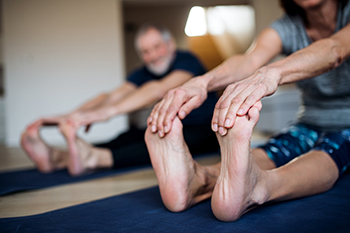

Studies have shown that the two main causes of injuries to women during pregnancy are car accidents and falling due to balance control problems. In fact, about one-fourth of pregnant women fall while pregnant, and many fall more than once. Data shows that most such falls occur indoors, and a large percentage of these involve stairs. Weight gain and shifts in a woman’s center of gravity are largely responsible. Walking balance and speed are also among the main contributors to falls during pregnancy. A third problem is thought to be a lack of total concentration on their external environment. Another potential cause of falling is being sedentary during pregnancy, which can decrease leg and foot strength and hamper the body’s ability to react quickly. For that reason, some experts suggest engaging in some form of light exercise. To find out more about the dangers of falls during pregnancy and how to prevent them, please consult a podiatrist.
Pregnant women with swollen feet can be treated with a variety of different methods that are readily available. For more information about other cures for swollen feet during pregnancy, consult with the podiatrists from The Foot & Ankle Center of New Jersey. Our doctors will attend to all of your foot and ankle needs.
What Foot Problems Can Arise During Pregnancy?
One problem that can occur is overpronation, which occurs when the arch of the foot flattens and tends to roll inward. This can cause pain and discomfort in your heels while you’re walking or even just standing up, trying to support your baby.
Another problem is edema, or swelling in the extremities. This often affects the feet during pregnancy but tends to occur in the later stages.
How Can I Keep My Feet Healthy During Pregnancy?
If you have any questions please feel free to contact our office located in Paramus, NJ . We offer the newest diagnostic and treatment technologies for all your foot and ankle needs.

Research has shown many people who enjoy running lack the appropriate time to properly stretch. The sport of running can range from jogging 15 minutes per day to preparing for a marathon. It is beneficial to learn how to prevent running injuries, and this generally begins by warming up and cooling down before and after running. Effective stretches for runners can include the hip flexor and quad stretch. This is done by kneeling on one leg, reaching back, and bringing the bent leg as close as possible to the buttocks. The hamstrings can easily get hurt if they are not stretched properly. Lying on the floor, raising one leg up, and using a band that is wrapped around that leg while pulling it forward is considered to be a good hamstring stretch. If you would like to learn about additional stretches that can help to prevent running injuries, it is suggested that you consult with a podiatrist who can help you to achieve your running goals without injury.
All runners should take extra precaution when trying to avoid injury. If you have any concerns about your feet, contact the podiatrists of The Foot & Ankle Center of New Jersey. Our doctors will treat your foot and ankle needs.
How to Prevent Running Injuries
There are a lot of mistakes a runner can make prior to a workout that can induce injury. A lot of athletes tend to overstretch before running, instead of saving those workouts for a post-run routine. Deep lunges and hand-to-toe hamstring pulls should be performed after a workout instead of during a warmup. Another common mistake is jumping into an intense routine before your body is physically prepared for it. You should try to ease your way into long-distance running instead of forcing yourself to rush into it.
More Tips for Preventing Injury
If you have any questions, please feel free to contact our office located in Paramus, NJ . We offer the newest diagnostic and treatment technologies for all your foot care needs.

When a stress fracture is incurred, it can be a runner’s worst nightmare. A stress fracture is a hairline fracture that happens from increased pressure on the feet while participating in running and jumping activities. Some patients have a predisposition to stress fractures, which may include having weak and narrow bones. The minimum recovery time for a complete recovery is six weeks and it is imperative to the healing process that running is stopped during this time. When the foot has healed, it is beneficial to begin running gradually and increase speed and distance slowly. Additionally, it can help to perform basic foot stretches to give the foot a chance to become stronger. If you have foot pain and are unable to run, it is suggested that you contact a podiatrist who can determine if a stress fracture has occurred, and offer you the correct treatment options.
Stress fractures occur when there is a tiny crack within a bone. To learn more, contact the podiatrists from The Foot & Ankle Center of New Jersey. Our doctors can provide the care you need to keep you pain free and on your feet.
How Are They Caused?
Stress fractures are the result of repetitive force being placed on the bone. Since the lower leg and feet often carry most of the body’s weight, stress fractures are likely to occur in these areas. If you rush into a new exercise, you are more likely to develop a stress fracture since you are starting too much, too soon. Pain resulting from stress fractures may go unnoticed at first, however it may start to worsen over time.
Risk Factors
Stress fractures do not always heal properly, so it is important that you seek help from a podiatrist if you suspect you may have one. Ignoring your stress fracture may cause it to worsen, and you may develop chronic pain as well as additional fractures.
If you have any questions, please feel free to contact our office located in Paramus, NJ . We offer the newest diagnostic and treatment technologies for all your foot care needs.

A hammertoe is typically found in the second and third toe and is characterized by a raised joint in the middle of the toe. The tip of the toe curls under the foot as the middle joint raises up. In the early stages, the hammertoe may still be flexible, but later on, it may become rigid. This deformity can be caused by the long-term wearing of high heels, which often have a small and pointed-toe box. Hammertoe also can be congenital or caused by arthritis. Symptoms of a hammertoe are curling toes, raised joints, callus formation under the affected toe, and pain on the affected joint from rubbing against the top of a shoe. Wearing shoes that fit properly is one way of decreasing the development of hammertoe because once it is formed it is likely to become permanent. Avoid wearing shoes that squeeze the toes together, especially those that force the weight of the body onto the ball of the foot. Treatment for hammertoe varies, depending on the severity of the deformity. Treatment can range from wearing protective pads or strapping down the toe, to surgery on the joint and removal of bone. For more information on dealing with a hammertoe and its side effects, it is suggested that you consult with a podiatrist.
Hammertoes can be a painful condition to live with. For more information, contact the podiatrists of The Foot & Ankle Center of New Jersey. Our doctors will answer any of your foot- and ankle-related questions.
Hammertoe
Hammertoe is a foot deformity that occurs due to an imbalance in the muscles, tendons, or ligaments that normally hold the toe straight. It can be caused by the type of shoes you wear, your foot structure, trauma, and certain disease processes.
Symptoms
Risk Factors
Treatment
If you have hammertoe, you should change into a more comfortable shoe that provides enough room for your toes. Exercises such as picking up marbles may strengthen and stretch your toe muscles. Nevertheless, it is important to seek assistance from a podiatrist in order to determine the severity of your hammertoe and see which treatment option will work best for you.
If you have any questions, please feel free to contact our office located in Paramus, NJ . We offer the newest diagnostic and treatment technologies for all your foot care needs.